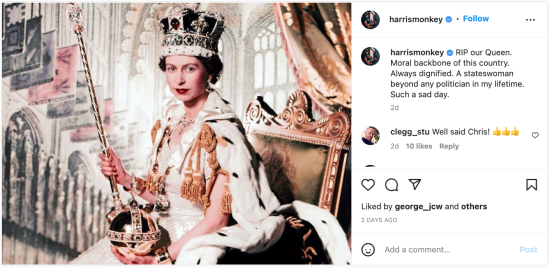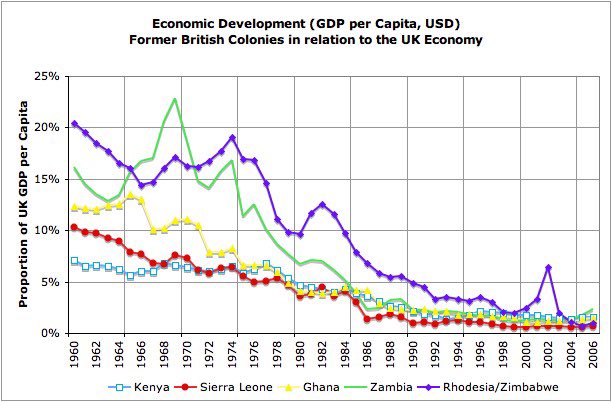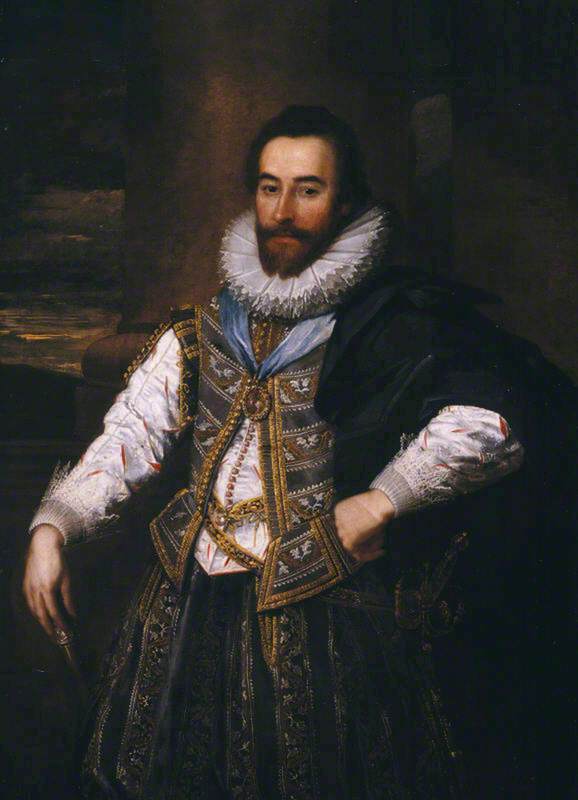
I never had the chance to meet her in-personi but I knew her face well, for it was plastered all over the $20 bills that I used to cash in (but mostly cash out)ii of poker games in my youth. Green-tinted though that enduring impression of her was, she was perhaps unenviably the “moral backbone”iii of the ironically setting sun of the British Empire.
Increasingly besieged as the reputation of her Monarchy was throughout the world – particularly for her former colonies, past subjects, and even present Commonwealth – for over 70 years Queen Elizabeth II‘s global influence steadily but surely declined,iv even if she fell from an awfully high perch. Yet in spite of that dimming backdrop and unfortunate timing, QEII had real influence, and not just as a low-key landlord.v How so?
In addition to showing boss women a concrete example of female power upon which to model themselves in a similarly essential fashion,vi the ol’ Viking left several important, if more subconscious, influences as well. Arguably it was her ever-present pearl necklaces that inspired the Mikimoto AAvii strand your not-terribly-humble author is wearing as he types this. Why not!viii On an equally serious note, The Greatest (And Most Rebellious) of All Possible Americas subconsciously paid tribute to her late Majesty with its post-GFC currency debasement programme. QE baby!!! How very Royal, n’est pas? Y’see, the Fed is paying attention. At the very least, it’s learned from her late Majesty the art of theatre, which is always and everywhere present in the highest offices of true power.
Observes arts writer Louis Jebb:ix
The controlled, carefully evolving, global visibility of Queen Elizabeth II was one of the great demonstrations of durational performance art. It was a feat made all the more remarkable by the consistency and longevity of its development, made possible by the Queen’s powers of concentration, stamina and presence of mind. She became a Marina Abramovic for the ages. […] Her life as Queen was a performance face-to-face with the public, in person or on television or online, akin to a long-range version of Marina Abramovic’s The Artist is Present (2010)—where Abramovic sat in place for three months, eight hours a day, while a succession of visitors to the Museum of Modern Art, New York, came to sit opposite her. ”It was a complete surprise,” Abramovic said, “this enormous need of humans to have contact”. But in the Queen’s case, answering the need of humans to have contact, to engage with her, lasted not for three months, but for more than 70 years.
Isn’t her life and legacy all the more impressive when viewed through this lens? More than 70 years of curating one’s public image so as to almost entirelyx avoid the gossip trap!xi
Not that we have all day to sit here and dwell on the past. For no sooner does one monarchic door close than the next must open. Or else… so now it’s onto the next. The Queen has left the building. Long live the King.
___ ___ ___
- Did you, anon? ↩
- Cash in cash out!
↩ - To quote British automotive journalist Chris Harris (archived), legendary power-slider of fast bits:

Moral backbone of this country! ↩
- Not that the decline in her Majesty’s global influence was always a good thing, mind you:

- The Queen formally owns over 6 billion acres of land, so you can ignore the headlines about her being “only a multimillionaire” or some shit. How she monetises and enforces that “ownership” is another question, mind you. ↩
- Hear me out: what if the whole “diversity” push is just because we’ve had below-replacement birthrates for 50 years and our continued societal functioning just requires that warm bodies fill positions in the workplace and in the field? Lest streets go unpaved, houses go unelectrified, children go uneducated, sick go untended, and our technological (and social) infrastructure generally crumble beneath the massive inherited load of the over-sized Baby Boomer generation? What if “diversity” is a practical patchwork born of necessity rather than an absolute moral good? Of course, this was avoidable if our parents had had 7 kids each, but that just wouldn’t have been very (sub)urban of them, now would it. ↩
- No, not AAA. What am I, made out of money?! ↩
- Even if it was probably my own mother who deserves most of the subconscious credit for that particular fashion foray, looking again at photos of the Queen makes the connection between power and pearls all the more evident in hindsight. Which I suppose just begs the question, what will King Charles III make cool? Vests like his namesake Charles II?
From Dressing Charles II : The King’s Clothing Choices (1660–85):
In contrast, the most frequently discussed innovation in dress that Charles II has been associated with was his decision to reject French fashion and to create a specifically English style – the vest – a fashion that Charles II stated he would ‘never alter’. Pepys described how the king adopted this style in 1666 when he noted in his diary on 17 October that ‘The Court is all full of vests ; only, my Lord St. Albans not pinked, but plain black – and they say the King says the pinking upon white makes them look too much like magpyes, and therefore hath bespoke one of plain velvet’. Pinking comprised small cuts or holes, often in geometric patterns, cut in the top fabric of outer garments. More detail was supplied by the writer and diarist John Evelyn (1620–1706) who noted on 18 October :
thence to Court, it being the first time of his Majesties putting himselfe solemnly into the Eastern fashion of Vest, changing doublet, stiff Collar & Cloake & ; into a comely Vest, after the Persian mode with girdle or shash, & Shoe strings & Garters, into bouckles, of which some were set with precious stones, resolving never to alter it.
While Evelyn’s description was fuller than that of Pepys, the references to the vest being Persian in style are rather misleading.
Orders for vests first appeared in the account for 1666-67 and they confirm the comments made by Pepys. A couple of vests were pinked as in the case of ‘a purple cloth coat and hose and the vest cut upon white taffeta with a purple garniture’. However, most were made of the same fabric as the rest of the suit, a contrasting and more expensive cloth such as a flowered brocade or heavily embellished. For instance, a black velvet coat lined with tabby and a coloured cloth vest and hose trimmed with gold buttons, the garniture of scarlet ribbons. Orders for vests continued to appear in the accounts until 1670 but after this, items described as waistcoats started to appear again. However, one question that the accounts do not address is how innovative this development was. Certainly the wish to be less reliant on French styles was not new. John Evelyn had written his pamphlet Tyrranus or the Mode five years earlier in 1661 in which he criticised the English fondness for French fashion. While he began by stating ‘I will not reproch the French for their fruitful Invention’, he went on to state his surprise at the English interest in anything French ‘of whom they speak with so little kindnesse’. In spite of writers such as Evelyn, later researchers have questioned whether the vest was an original idea ; a range of suggestions have been put forward including that it was influenced by Netherlandish or French styles in spite of Charles II’s protestations. In light of the short-lived nature of the ‘English’ vest, what was most important for Charles II was that he was able to claim a break with French style and influence at a time when the relationship between the two countries was strained.

Robert Sydney (1595–1677), 2nd Earl of Leicester, KG, KB
Anthony van Dyck (1599–1641) (style of)
National Trust, Powis Castle - Archived. ↩
- Of course no one escapes this life without at least a few stains on their record, not even the late QEII. Notes British historian James Vernon (archived):
As ever in British history, much is about change but even more is about what has not changed. This Queen was an imperial monarch. Her coronation was an imperial event that evoked what some hoped would be a new age for what was still a very large Empire. As the head of Empire she symbolised its racial order of white supremacy. Her reign, like the crown littered with jewels “gifted” from the colonies, took its wealth and authority from centuries of colonial subjugation. For some Britons she connected them to that imperial past in ways that made them proud. For others it was a source of pain or shame.
As the empire, and the attempt to make Europe fill the gap left by it, fell apart, the Queen became the head of a United Kingdom which itself began to disintegrate with decolonization and Brexit. She became a symbol of Britain’s precarious and shrinking place in the world.
The other big hope at her coronation was that she could revive the family romance of the monarch after the Abdication Crisis (King Edward VIII renouncing the throne). Yet, as viewers of The Crown know, her family was just like everyone else’s: tension, resentments, affairs & broken marriages.
As head of the royal family and the Anglican Church she could not make the center hold. She was much more effective holding on to her enormous personal wealth than the church was, but she neither restored faith in the sanctity of the family or the authority of the church.
Ultimately her reign was one in which royalty was reduced to becoming part of a new culture of celebrity. She made it that way by embracing radio and TV, and jet-set tours, to reach ‘her’ peoples around the restyled Commonwealth.
And yet the so often distasteful & ugly stories that circulated around her family (adultery, sexual abuse, racism, corruption) reduced the monarchy to just another very rich celebrity figure with a global audience.
It is hard to know whether the inevitable avalanche of mourning and reporting in the days ahead speaks to the way the monarchy still matters for many Britons. I suspect instead she represents an earlier time and a nation/empire many still wished they lived in.
- Mega-recommended long read by Erik Hoel is archived here. ↩
